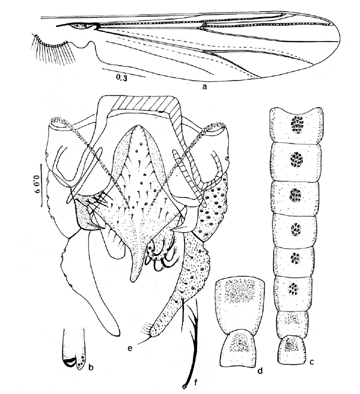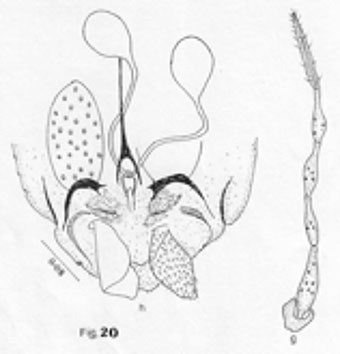Chironomus ramosus Chaudhuri et al. 1992Incorrect identification: C. ramosus sensu Laviad-Shirit et al., 2020 (C. flaviplumus Ty. B - Martin 2022). This species has been recorded as C. sp.PK7 in previous versions of this work. Original description: Adult Body 5.77 (5.62-5.89) mm. Wing length 2.33 (2.27-2.40), wing width 0.72 (0.70-0.76) VR 1.01 (1.00-1.03). Head: AR 3.86 (3.72-3.94). Frontal tubercles small; ratio of palp segments: 14 : 11 :47 : 48 : 66. Clypeal setae 20 (18-20). Thorax yellow, postnotum pale brown; 2 antipronotal setae. Mesonotum with 4 brown vittae; fore tibial scale with 4 long setae; tarsomeres of foreleg dark brown, Ta1-3 of mid and hind legs brown at apex, Ta4 & 5 brown. Leg proportions and ratios (units): Leg pale; lengths (micron) and proportions as follows:
Abdomen: Greenish yellow, tergites II-VI with brown oval spot medially; VII & VIII with broad brown patch.  Adult male of C. ramosus (Chaudhuri, Das and Sublette 1992) Curved anal point figured as tapering to end, beak-like superior volsella (as in C. samoensis, C. flaviplumus, etc.), S-type, closest to Fig. a of Strenzke (1959); setae of inferior volsella finely branched. Gonostylus moderately swollen, narrowing gently over posterior half to third. Female:  Female genitalia of C. ramosus (Chaudhuri, Das and Sublette 1992) TX shown as long, curved, but inner region with setae not shown; other specimens show it is about 1.67x longer than greatest width, with 14 setae; Cercus with short dorsal margin, then curved around to ventral base; no obvious basal bulge. Found: Type locality - Satgachhia, West Bengal, INDIA. Larva, pupa and adult described by Chaudhuri, Das & Sublette (1992). Chromosomes described by Nath & Godbole (1997). In their map, chromosome I is comprised of arms D and C, chromosome II of arms F and B; chromosome III of arms A and E, and chromosome IV is arm G. As noted, the nucleolus in the map is at 11B in arm B, but in other specimens, the nucleolus is in arm F at 10D. Since the available specimens have all come from an inbred laboratory stock, it is not clear what the situation is in natural populations (see C. ramosus immatures) |
Modified: 3 August 2025
Access: Unrestricted
Copyright © 2010-2025, Jon Martin.